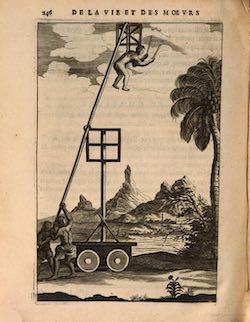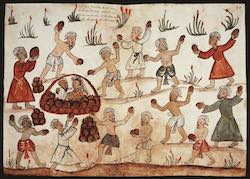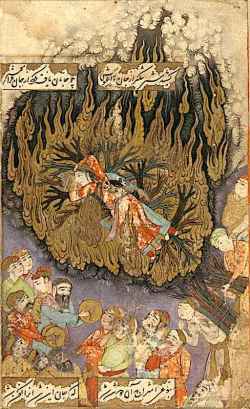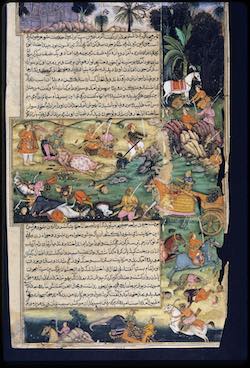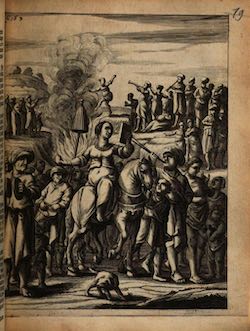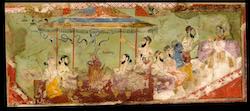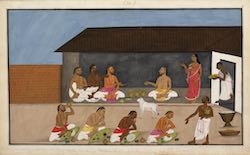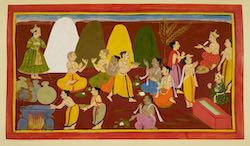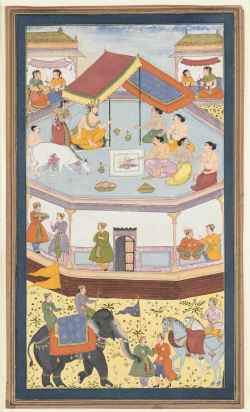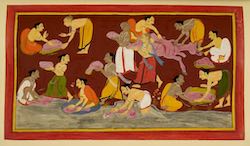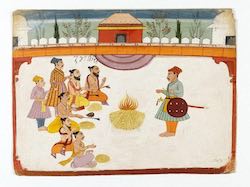Keyword: India
Ritualistic hanging from a carriage during the procession, as part of ceremonies in honor of Ganga. Numerous goats were sacrificed during this event (1670)
from: Abraham Rogerius, Le Théâtre de l’idolatrie ou la porte ouverte, Amsterdam, Jean Schipper, 1670, p. 246
Sati Funeral Practice (1611)
from: Johannes Isacius Pontanus, "Rerum et urbis Amstelodamensium historia", Amsterdam, 1611, p. 189
Satī. Gentile women of the caste of the cattle drivers, who is buried alive with her husband after he had died [1540]
Codice Casanatense, Biblioteca Casanatense, ms. 1889, fol. 64r, Rome
Satī. The bride immolates herself on the funeral pyre (1657)
from: Isfahan, Iran
The Israel Museum, Jerusalem
Satrughna is wounded by Kusa and Lava during Rama's horse-sacrifice (1616)
from: Leaf from a dispersed manuscript of Razmnama
Harvard University, Fine Arts Library, SS_22349926
Scene of a Sati, with a woman throwing herself into the flames amid a crowd playing trumpets. Above, a winged devil holds the banner with the book's title and the torch with which he lights the ritual fire. (1670)
from: Abraham Rogerius, Le Théâtre de l’idolatrie ou la porte ouverte, Amsterdam, Jean Schipper, 1670, title page
Scene of a sati. In the foreground, a widowed woman (encountered by Della Valle on November 12, 1623) on horseback holds a mirror and a lemon amidst a crowd. In the background, a woman throws herself into the flames of a funeral pyre (1665)
from: Della Valle, Pietro, De volkome beschryving der voortreffelijke reizen van de deurluchtige reisiger Pietro della Valle, edelman van Romen, in veel voorname gewesten des werrelts, sedert het jaer 1615, tot in 't jaar 1626 gedaan. Amsterdam, Abraham Wolfgang, 1666, vol. 5, pag. 163
Snake Sacrifice [1690]
from: Udaipur, Rajasthan state, Mewar, India
Henri Vever Collection, Freer|Sackler gallery at the Smithsonian Institution
Suttee (1878)
from: Murray Smith, D. Round the World: A Story of Travel Compiled from the Narrative of Ida Pfeiffer, London, 1878
http://www.columbia.edu/itc/mealac/pritchett/00routesdata/1800_1899/hinduism/sati/sati.html
Suttee Pillar at a Benares Burning Ghat (19th century)
http://www.columbia.edu/itc/mealac/pritchett/00routesdata/1800_1899/hinduism/sati/sati.html
Sutteeism on the Banks of the Ganges (1860)
from: Montgomery Martin, R. The Indian Empire, c.1860
http://www.columbia.edu/itc/mealac/pritchett/00routesdata/1800_1899/hinduism/sati/sati.html
The Ekahum ceremony, consisting of the release of a bull. A young bull stands in the courtyard of the deceased's house. His eldest son performs a sacrifice with rice, plantains and three brass pots of water decorated with mango leaves. The widow is dressed in her finest clothes and a feast is given to the Brahmins (ca 1820)
from: The Lives of the Brahmins [Ms Add.Or. 4354]
British Library, London
The feast before the sacrifice (1712)
from: Ramayana, Bala Kanda, Ms Add. 15295, fol. 31
British Library, London [from Udaipur]
The Funeral Pile of a Husband (1810)
http://www.columbia.edu/itc/mealac/pritchett/00routesdata/1800_1899/hinduism/sati/sati.html
The sacrificed horse is prepared (1712)
from: Ramayana, Bala Kanda, Ms Add. 15295, fol. 34
British Library, London [from Udaipur]

